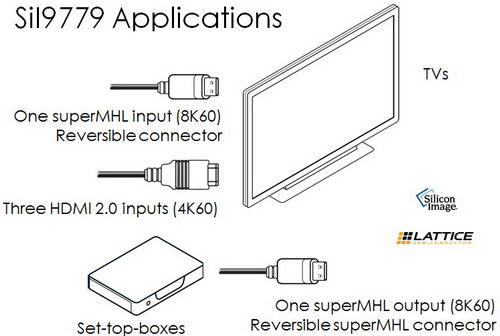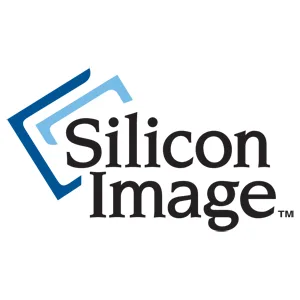At CES, the MHL Consortium announced the superMHL specification. This specification, when implemented by CE manufacturers, will allow 8K 120Hz video to connect from the source to the display with a single cable.
On March 16th, the other shoe dropped. Lattice Semiconductor, which recently acquired Silicon Image, the driving force behind the original MHL specification, announced on March 16th the first superMHL port processor, the SiI9779. This chip is intended to be used either in an 8k TV or a dedicated 8k set top box. When used at the receiving end of a video stream in a TV, the SiI9779 can handle one superMHL connector and three HDMI 2.0 connectors. When used as a transmitter in an STB, it can transmit only the superMHL signal, not HDMI signals. While the superMHL specification allows 8K 120Hz video, the SiI9779 chip can only handle a maximum of 8k at 60Hz.

The SiI9779 supports key features such as:
- 8k60 resolution
- BT.2020 expanded color gamut
- High Dynamic Range such as Dolby Vision
- Reversible connector (top-to-bottom, end-to-end)
- Latest audio features including object audio, high resolution and high bit-rate audio such as Dolby Atmos, DTS:X, 3D audio
- Audio-only mode
I had a chance to talk to Marshall Goldberg of Lattice Semiconductors, formerly of Silicon Image. He is the Sr. Product Manager at Lattice for the SiI9779. He said that by 2018 DisplaySearch predicts that virtually 100% of TVs 55″ and larger will be 4k and manufacturers are looking to the success of 4k as justification to move beyond it to 8k. He said the 8k demonstration at CES on a 110” display had been very well received, both by the consumer electronics people who saw it and by the production and post-production people.
HDMI, the original basis for MHL connectivity, was originally intended as a consumer interface, just like superMHL. However, HDMI has been widely adopted by professional applications as a single cable, uncompressed solution to display connectivity for both 2k/HDTV and 4k/UHD applications. (I’m writing this article on a laptop connected to a monitor via HDMI.) Since superMHL is the only single-cable solution to 8k video currently available, even as a specification, Goldberg sees it moving into the professional market as well as the consumer market.
According to Goldberg, the superMHL standard is uncompressed at “lower” data rates such as UHD 60Hz. At the extreme data rates superMHL is capable of, such as 8K120 with HDR, visually lossless compression is applied, with compression ratios in the 2x – 3x range (using the VESA DisplayStream standard – Man. Ed.). When used with HDR signals such as Dolby Vision, superMHL transmits metadata to the TV or other display that tells the display exactly what the HDR is, whether it is Dolby Vision or some other HDR technique. It’s then up to the TV electronics to display the video correctly.
The superMHL connector is reversible in two senses. First, it is (or at least can be) the same on both ends, unlike, for example, earlier versions of USB. Second, each connector is reversible top-to-bottom, so if you are fumbling around behind a display in the dark, you don’t have to worry about reversing the connector to plug it in.
Goldberg said Lattice Semiconductor will be sampling the SiI9779 in Q2 to TV, display and set top box manufacturers.
8k content? Goldberg said the first planned 8k availability will be in 2020 when NHK plans to broadcast the Tokyo Summer Olympics. Manufacturers have plenty of time to ramp up 8k STBs and TVs before then. He added that there are likely to be professional and PC graphics applications for 8k before then. – Matthew Brennesholtz

